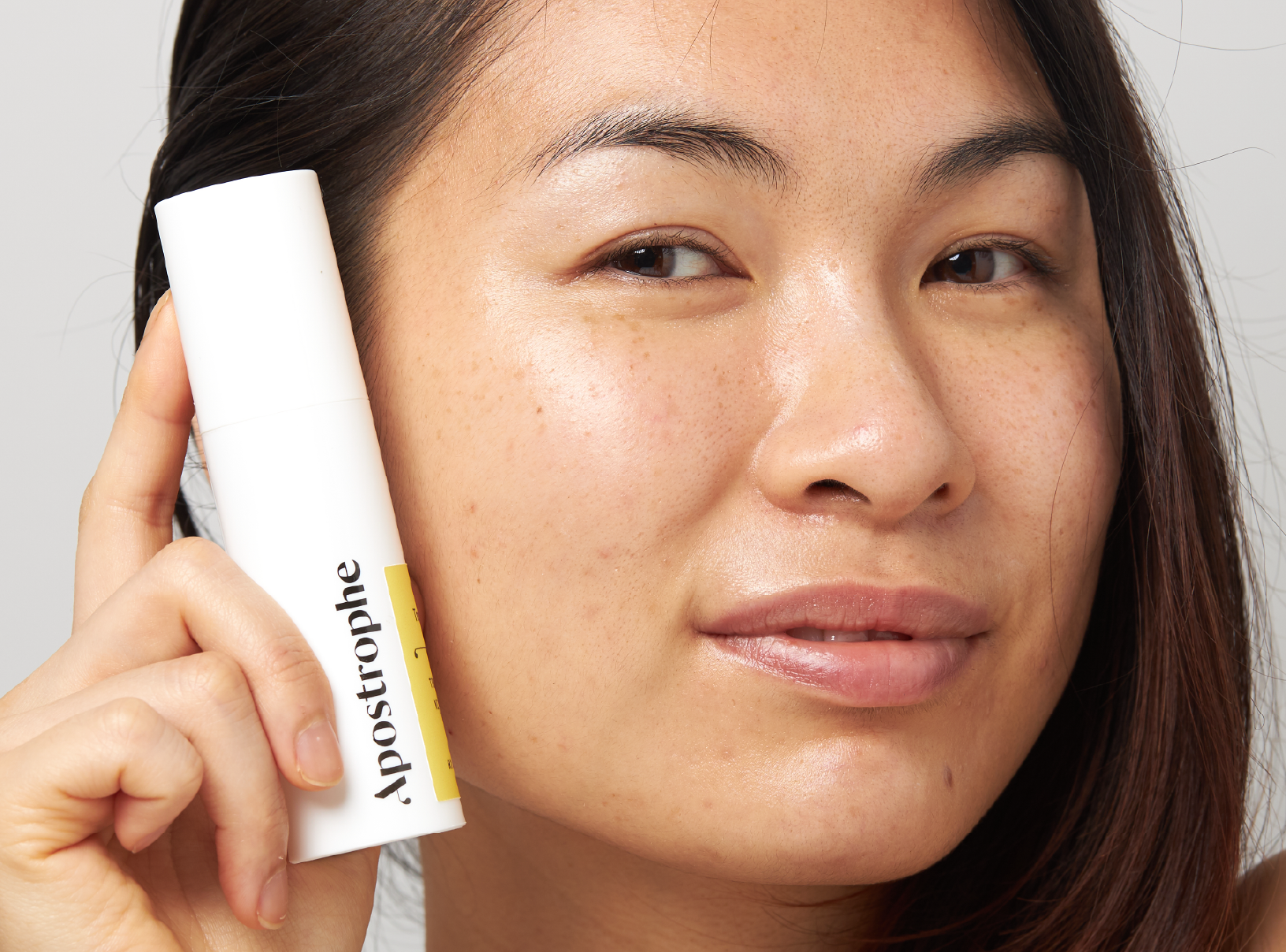Education
Hormonal Cystic Acne On The Chin Causes And Treatments
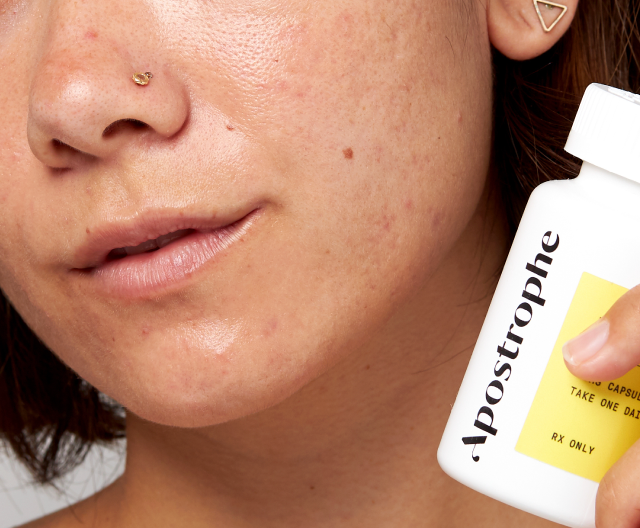
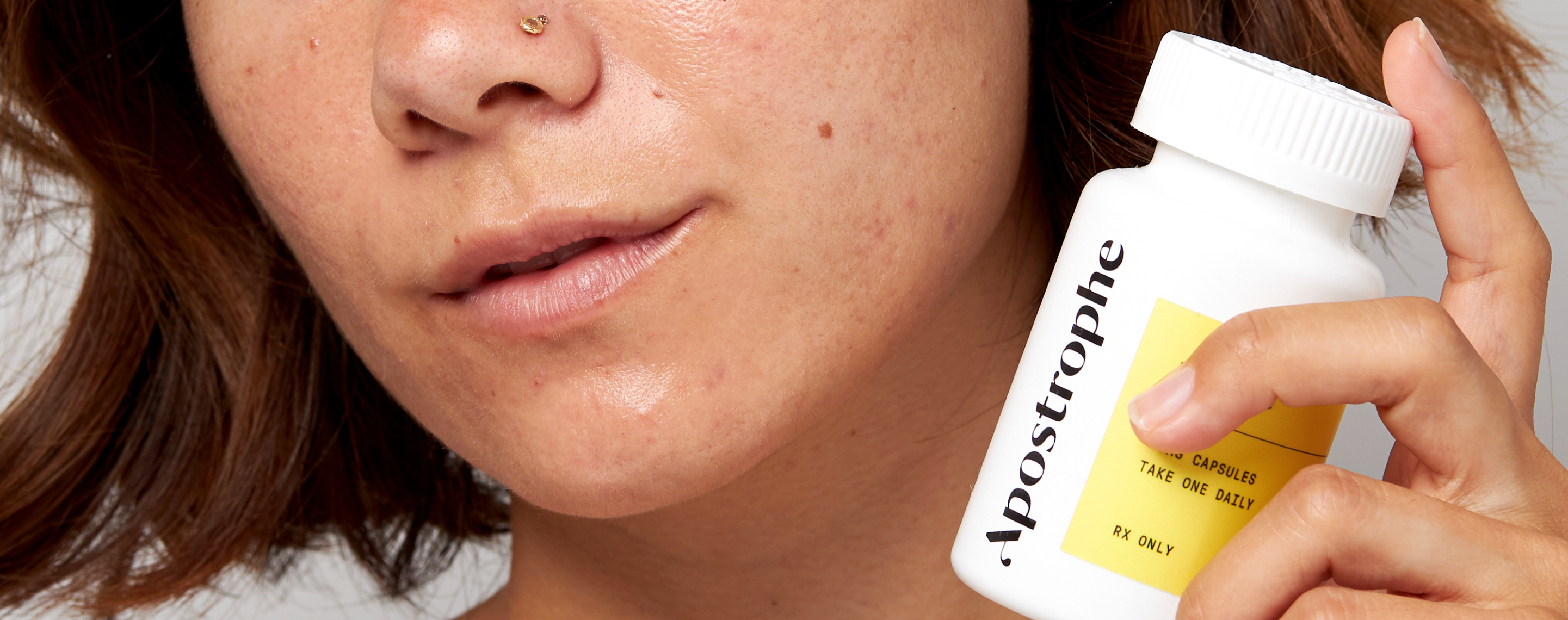
SHARE
Education
Hormonal Cystic Acne On The Chin Causes And Treatments
Medically reviewed by Aimee Paik, MD
Written by Apostrophe Team
Last updated 8/1/2024
Hormonal Cystic Acne on the Chin: Causes and Treatments
Your 20s are supposed to be filled with exciting work and new adventures—not hormonal cystic acne. Yet the International Review of Women’s Dermatology finds that more than 50% of women aged 20 to 29 struggle daily with this skin condition.
But there’s hope. By better understanding the causes of hormonal cystic acne, we can more effectively treat it.
In this post, we’ll discuss the causes and treatments of hormonal acne, focusing on what you can do to manage and prevent your hormonal acne so that major breakouts are things of the past. We’ll specifically touch on the following:
The characteristics of hormonal acne
The reasons why you get hormonal acne on your chin and jawline
Why chin acne is treated differently than other types of acne
Treating hormonal acne with anti-androgen blockers and topical treatments
What Are the Characteristics of Hormonal Acne?
Although acne is usually seen as a teenage problem caused by several factors—including clogged pores, inflammation, and excess oil production—hormonal acne can start in your 20s and continue well into adulthood. And as its name indicates, hormonal acne is caused specifically by hormonal fluctuations and spikes.
While there’s still much research to be done in terms of what triggers these hormonal spikes, acne from hormonal imbalances is typically associated with:
Menstrual cycles
Menopause
Increased androgens
What are androgens? This group of hormones is similar to testosterone in that they play a role in developing male sexual traits. However, like testosterone (and estrogen), androgens are prevalent in people of all genders. Amongst their many physiological functions, androgens regulate the production of sebum (skin oil).
That means that while this type of acne is more common in women, it can affect anyone.
The following are common characteristics of hormonal acne:
Hormonal acne can be more inflammatory, though whiteheads and blackheads, do show up.
Hormonal cysts tend to be more painful and inflamed, and their deeper appearance in the skin makes it more difficult to remove them without scarring.
Often cyclical, hormonal acne coincides with menstrual cycles and appears in the same area over and over.
Cysts most commonly appear along the chin and jawline due to excess hormones stimulating oil glands in these specific areas.
While most people’s first question pertains to how to get rid of hormonal acne, many then wonder why hormonal acne is so common on the chin and jawline. Next, we’ll take a deeper look at the factors that contribute to the prevalence of this type of acne in these specific areas.
Why Do You Get Cystic Acne On Your Chin?
Just as regular acne can appear anywhere on your body, so too can hormonal acne. However, because the chin and jaw have more oil glands (and androgens are known to affect sebaceous glands), these areas are more prone to breakouts. In other words, the oil glands on the chin and jawline produce more sebum as a reaction to hormonal changes.
Yet, there may be other reasons why the chin and jawline are such hotbeds for cystic acne. These include:
Wearing clothing that rubs across the neck, such as turtlenecks, high collars, and helmet straps.
Repeatedly touching this part of the body. For instance, resting your chin in your hands introduces bacteria and debris that may potentially lead to acne.
Either of these actions can cause normal acne, which in turn exacerbates hormonal acne.
Whatever its root causes, chin acne is a distinct skin condition that must be treated differently from other types of acne.
Is Chin Acne Treated Differently from Other Types of Acne?
In a perfect world, all acne would be treated with the same minimally invasive techniques. However, because hormonal acne tends to appear deeper in the skin than other types of acne, hormonal cystic acne on the chin requires a different approach.
Let’s look at the specific reasons as to why a different approach is needed:
Because cystic acne tends to appear deeper, proper extraction is difficult and can lead to scarring. Trying to manually extract clogged pores through popping and picking at your pimples can push the bacteria in even deeper and lead to more inflammation.
Topical treatments may not be as effective due to the depth of cystic acne. The reason? Most topical ingredients used in general skincare cannot reach the cyst. That’s why treatment usually involves both oral and topical medications. When used together, oral treatments will help calm inflammation, while topical treatments can unclog pores, preventing new acne from forming.
Before we look at possible treatments, let’s first discuss a much-debated topic: the relationship between food and hormonal acne.
Do Foods Trigger Hormonal Acne?
While specific foods aren’t known to contribute to acne directly, there’s sufficient evidence to suggest that diet can influence your health and hormones.
Diets with a high glycemic index, for instance, cause blood sugar spikes which in turn increases insulin production. And increased insulin means increased androgens.
What’s more, studies have shown a correlation between diets high in processed and refined carbs and the severity of acne. Diets that avoid heavily processed carbohydrates and sugary beverages are thus helpful in preventing androgen production that can cause a cystic breakout.
How Do You Treat Hormonal Acne Around the Mouth and Chin?
The most immediate thing you can do is resist the urge to pick, pop, or otherwise touch your acne. Not only does touching your skin introduce more bacteria, dirt, and debris to your pores, but it also contributes to scarring, inflammation, and more breakouts.
Yet resisting the urge to pick at your acne only addresses the symptom, not the root causes. As stated above, any hormonal acne treatment plan should incorporate both oral and topical treatments for the most effective treatment regimen.
Let’s break down the specifics of each treatment, beginning with oral treatments that manage hormones.
Hormonal Treatments
Hormonal treatments regulate hormones to control oil production. These types of treatments come in primarily two forms: oral contraceptives and androgen receptor blockers.
Oral contraceptives help control sebaceous gland activity by decreasing the production of adrenal and ovarian androgens.
Androgen receptor blockers such as spironolactone subdue sebum production.
Spironolactone is a particularly effective androgen receptor blocker produced in both topical and oral forms. However, due to its testosterone-decreasing properties, oral spironolactone should only be taken for acne treatment by women only. It is used for other conditions such as heart failure in both men and women because of its anti-androgenic properties.
Topical spironolactone, on the other hand, can be used by anyone. It represents a good option for a lot of people because it doesn’t come with the oral version’s systemic side effects.
If you’re interested in topical treatments, check out our topical spironolactone. Consult with an expert dermatology provider, find your perfect topical, and receive an online acne prescription, all without leaving the house.
Antibiotic Treatments
Because they keep down inflammation and reduce acne causing bacteria, antibiotics can be part of an effective treatment regimen. Antibiotics are commonly used in the short-term (roughly 3 months) and may also be paired with topical treatment as well.
The following are the most commonly prescribed antibiotics:
Doxycycline: An oral antibiotic known to reduce inflammation powerfully, its benefits include improving moderate-to-severe acne and rosacea, as well as helping to get acne under control until topical treatments kick in. It’s important to note that Doxycycline is effective only while you take it. Unless you use a topical treatment in conjunction, stopping Doxycycline will result in acne coming back.
Minocycline: Similar to Doxycycline, Minocycline is an antibiotic that targets inflammation. As an added benefit, it causes less sun sensitivity than Doxycycline.
Sulfamethoxazole-Trimethoprim: Having the longest name of the bunch, Sulfamethoxazole-Trimethoprim is similar to both Doxycycline and Minocycline in that it addresses inflammation. This antibiotic is often prescribed to combat severe inflammation when other antibiotics aren’t options.
Like spironolactone, you can get access to these antibiotics through Apostrophe. For more information, check out the antibiotics the providers on our platform prescribe.
Topical Treatments
As stated above, topical treatments can be a very effective way to treat hormonal cystic acne when used in conjunction with oral treatments. And while it’s true that most topical treatments can’t reach deep enough to influence a cystic breakout, they can unclog pores and prevent “regular” breakouts that exacerbate cystic acne.
Topical treatments that include retinoids and azelaic acid may reduce acne breakouts.
BHAs may penetrate deeper into pores to remove excess sebum.
And, again, don’t forget about the immense benefits of topical spironolactone. According to The Journal of Dermatology, topical 5% spironolactone reduced oil production at 12 weeks without any noticeable side effects.
How Apostrophe Helps Put an End to Cystic Acne, Period
Although hormonal cystic acne may seem like a problem you’ll have to deal with for the rest of your adult life, it doesn’t have to be. With advances in research, especially regarding androgen receptor blockers and topical treatments, managing and preventing your hormonal cystic acne has never been more doable.
And the even better news? With Apostrophe, you don’t have to fight hormonal cystic acne alone. In a world dominated by “natural cures” and “internet hacks,” our oral and topical treatments are backed by science. The dermatology providers on our platform will put together a personalized acne treatment that works.
Which acne treatment is right for your skin? Connect with a dermatologist or other healthcare provider to get information about how to keep your hormonal cystic acne under control.
Check out Apostrophe today and start your journey to healthy skin.
Shop this post
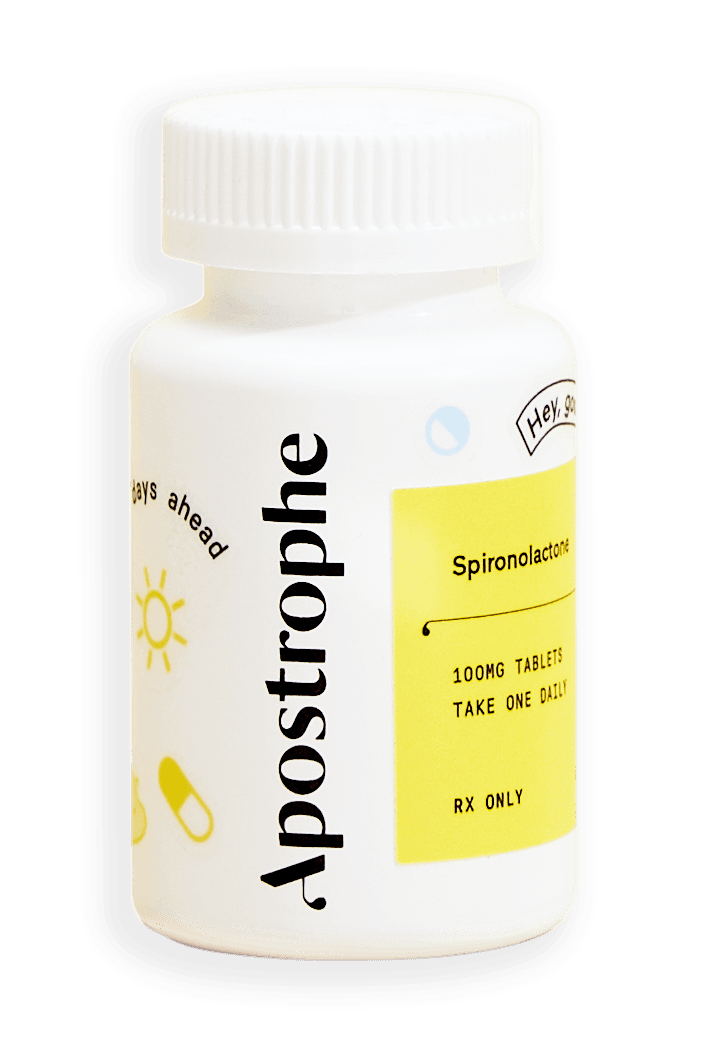
Oral Spironolactone
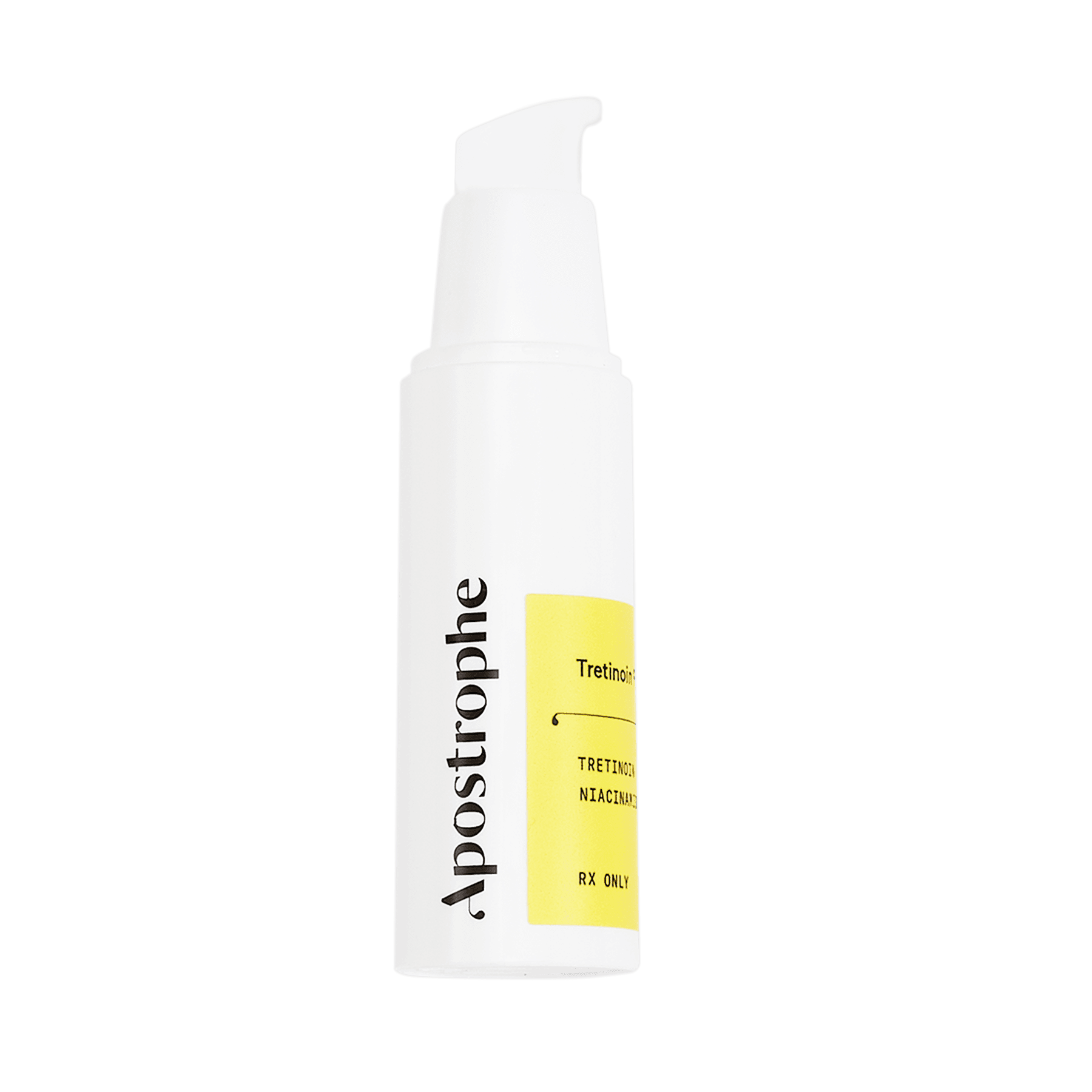
Topical Spironolactone

Oral doxycycline

Oral minocycline

Oral sulfamethoxazole-trimethoprim

Finacea (azelaic acid)
Like what you just read? Sign up for our email list to get the scoop on skincare science delivered straight to your inbox.

Deep Dives
A dermatologist shares his thoughts on the recent studies about benzoyl peroxide and benzene.
Read More
Education
What is milia?
What is milia? Today, we’re jumping into one type of bump that you may have heard about most commonly in infants — milia.
Read More
Education
Best moisturizer for acne-prone skin
If you have combination acne-prone skin, figuring out which moisturizer is best for your skin might be tough. In this guide, we break down the best moisturizer for combination, acne-prone skin.
Read More